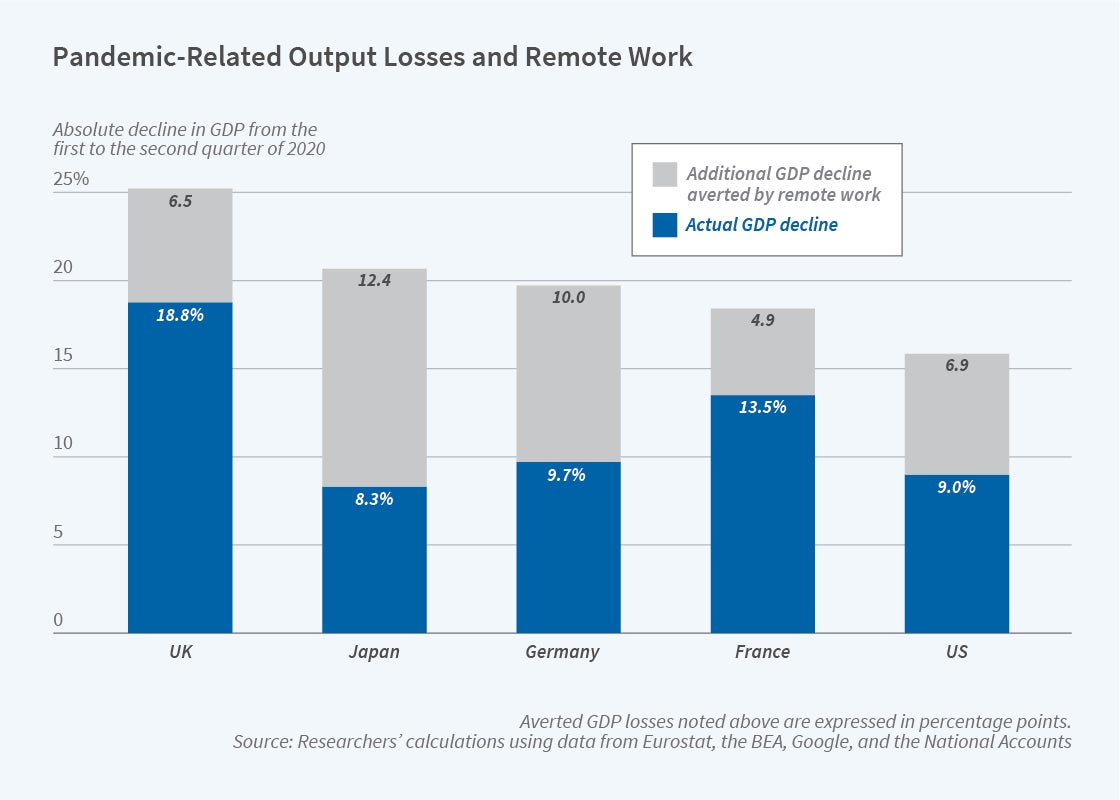‘At-Home Capital’ Attenuated COVID-Related Output Losses

Access to home office space, home computers, and the internet, when paired with at-home labor, substantially trimmed the output losses associated with business closures.
The COVID-19 pandemic reduced total economic output by an average of 13 percent between the first and second quarters of 2020 across the United States, the United Kingdom, Spain, France, Italy, Germany, and Japan. In “Potential Capital,” Working from Home, and Economic Resilience (NBER Working Paper 29431), Janice Eberly, Jonathan Haskel, and Paul Mizen calculate that this large output decline is substantially smaller than one might have predicted from pre-pandemic productivity patterns and the sharp decline in at-work labor and capital utilization. The difference is accounted for by the rapid rise in remote work and the significant amount of business output that it generated.
Analyzing national labor hours and energy-use data, the researchers find that while traditional workplace output fell in early 2020, gains in at-home output partially offset this decline. “At-home capital,” which they also call “potential capital,” such as home office space, computers, and the internet, when paired with at-home labor, facilitated at-home output. They estimate that a 1 percent increase in this capital increases total output by between 4 and 14 percent, similar to prior estimates of the impacts of office-based information and communication technology (ICT).
Remote work rose more in industries with a higher share of capital in ICT before the pandemic, highlighting the potential role of technological investment in building economic resilience. The researchers estimate that 8 to 14 percent of GDP during the trough of the COVID recession was attributable to this technological resilience. If at-home capital had not been deployed as effectively during the pandemic, for example if internet access had been more limited than it was, or video conferencing technology had not been as successful, pandemic-related shutdowns could have produced significantly larger losses in economic output.
While these findings inform the economics of the COVID-19 period itself, they have potentially long-lived implications for the future of production and work. If work-from-home (WFH) was productive during the pandemic, will it remain prevalent when office work is once again feasible? The answer must hinge in part on the ability to substitute at-home tasks for traditional workplace tasks. To the extent that WFH was motivated by elevated workplace costs like required safety precautions, the level of WFH may drop as the pandemic recedes and these costs fall.
The researchers analyze industry-level data from the UK to estimate the substitutability of at-home tasks for at-work tasks. They estimate that in a number of industries, at-home tasks are very good substitutes for at-work tasks. This raises the prospect of remote work remaining prevalent even as some at-work expenses recede with the pandemic.
— Lucy E. Page


